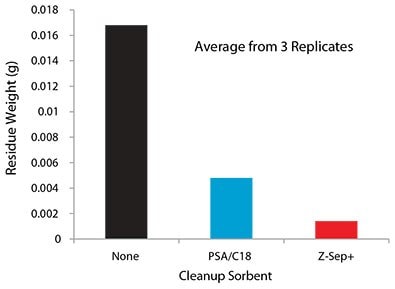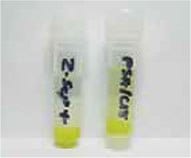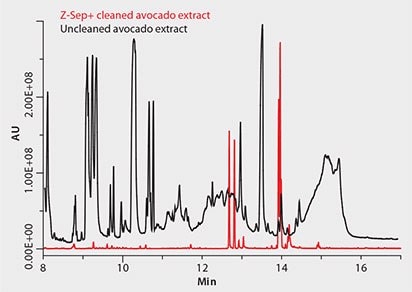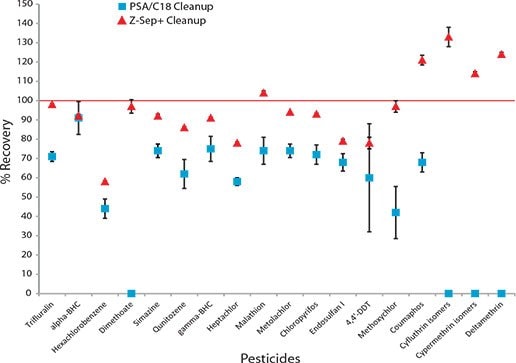Increase Removal of Fat and Pigment from Avocado Extracts Prior to GC-MS Analysis of Pesticide and Metabolite Residues
Katherine K. Stenerson, Jennifer Claus
Reporter US Volume 31.2
The health benefits of avocado are associated with its high content of healthy fat, fiber, vitamins, and minerals. Avocado consumption in the United States has steadily grown, with sources of the fruit being both domestic and imported1. The fat content of avocado is typically in the range of 10-15%, and this can pose a special analytical challenge when performing pesticide residue analysis. If not removed, fat compounds can interfere with analysis, resulting in elevated detection limits and contamination of LC and GC systems. The same issues can result from pigments; therefore, the effective removal of these compounds is also critical.
QuEChERS Cleanup Sorbents
QuEChERS (Quick, Easy, Cheap, Effective, Rugged and Safe) has become a very popular method for the extraction and cleanup of fruit and vegetable samples prior to pesticide residue analysis2-4. The extraction step uses a salt (such as magnesium sulfate) to drive compounds into acetonitrile, added as the extraction solvent. Cleanup is then accomplished using dispersive SPE (dSPE) with sorbents that include:
- PSA (primary-secondary amine) – for removal of polar pigments, sugars, and organic acids
- C18 – for removal of lipids and non-polar components
- Graphitized carbon black – for removal of chlorophyll and carotenoids
It is common to use blends of cleanup sorbents based on the interferences that need to be removed. Due to the fat content of avocado, a PSA/C18 blend is appropriate for extracts intended for pesticide analysis.
Recently, a new cleanup sorbent, Supel™ QuE Z-Sep+, was developed. This sorbent consists of both C18 and zirconia bonded to the same silica particles. The C18 binds fats through hydrophobic interaction, while the zirconia acts as a Lewis acid, attracting compounds with electron donating groups; such as the hydroxyl (-OH) groups in mono and diglycerides.
Experimental
In this work, Z-Sep+ is compared to a PSA/C18 blend for effectiveness in the QuEChERS cleanup of avocado extracts prior to pesticide residue analysis by GC-MS. Extraction and cleanup procedures are summarized in Table 1. Multiple replicates of both unspiked and spiked avocado samples were processed. Spiked samples were prepared with a mixture of hydrophobic and polar pesticides, each at 20 ng/g. All extracts were analyzed by GC-MS using large volume injection (LVI). Quantitation was done using a calibration curve prepared with matrix-matched standards.
Matrix Removal
Gravimetric analysis was performed on avocado extracts, cleaned and uncleaned, to determine the level of matrix residue remaining in the supernatants. This data is displayed in Figure 1. The results clearly show that significantly less residue remains in cleaned extracts, and Z-Sep+ sorbent removes more matrix than PSA/C18.

Figure 1. Comparison of matrix residue remaining.
Pigment Removal
Extracts were visually compared for color remaining after. As shown in Figure 2, less color remained in the extract cleaned with Z-Sep+. This indicates Z-Sep+ has a greater capacity for pigment removal than PSA/C18.

Figure 2.Avocado extracts after cleanup.
Chromatography
Figure 3 shows GC-MS total ion chromatograms (TICs) in full scan mode of uncleaned and Z-Sep+ cleaned avocado extracts. Much less background is observed in the TIC of the Z-Sep+ cleaned extract than the uncleaned extract. This indicates that Z-Sep+ can be effectively used to reduce unwanted matrix background in difficult samples such as avocado.

Figure 3.GC-MS chromatograms (same y-axis).
Conditions
Column: SLB®-5ms, 20 m x 0.18 mm I.D., 0.36 µm (Product No. 28576-U); oven: 70 °C (2 min), 15 °C/min to 325 °C (6 min); inj. temp.: Programmed, 25 °C (0.89 min), 600 °C/min to 325 °C (5 min); detector: MS Scan mode; carrier gas: helium, 1 mL/min constant; injection: 10 µL LVI, PTV solvent vent, rapid injection speed, split vent; flow: 100 mL/min (5 psi) until 0.28 min, 60 mL/min at 2.78 min; liner: 4 mm I.D., split type, wool packed FocusLiner™ with single taper design
Pesticide Recovery
Use of a cleanup sorbent should not adversely affect the recoveries of the analytes of interest. This was studied for both Z-Sep+ and PSA/C18 by determining the average recovery and reproducibility of 3 replicate spiked avocado samples cleaned with each sorbent. The results are depicted in Figure 4, showing average % recovery and the recovery range obtained for each pesticide. Recovery was better for most pesticides using Z-Sep+. In the case of PSA/C18, matrix interference prevented analysis of cyfluthrin, cypermethrin, and deltametrin. Reproducibility obtained with Z-Sep + cleanup was also better than PSA/C18, as indicated by the tighter recovery ranges indicated in Figure 4.

Figure 4.Average recovery and range (n=3).
Conclusion
The data presented here indicates that Z-Sep+ sorbent can be effectively used to remove fat and pigment interferences from avocado, a high fat matrix. It was found to remove more matrix from avocado extracts than traditional PSA/C18 sorbent, and produce a lower background when analyzed using GC-MS. Recoveries of pesticides of polar and lipophilic character were good, indicating no adsorption problems for these analytes.
Legal Information
SLB is a registered trademark of Sigma-Aldrich Co. LLC
Supel is a trademark of Sigma-Aldrich Co. LLC
FocusLiner is a trademark of SGE Analytical Science Pty Ltd.
References
如要继续阅读,请登录或创建帐户。
暂无帐户?